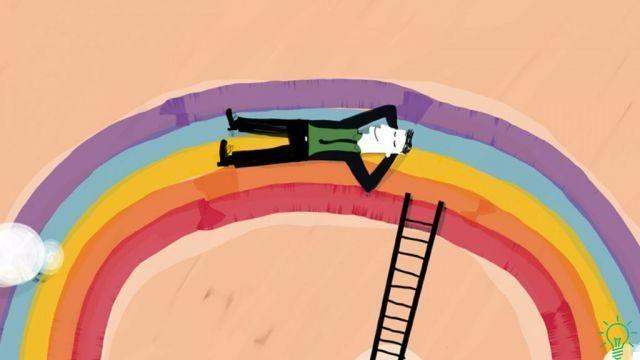
Our body during a panic attack is at the mercy of the threatening thoughts that flood our mind. In fact, in an anxiety crisis the problem is not in the body but in the thoughts we feed. Our body simply responds in a coherent way to the danger signal that these thoughts have generated.
Understanding the consequences of a panic attack on the body is important as research suggests that around 13% of people around the world have already experienced an anxiety attack at least once. If this episode is not managed properly, it can end up becoming chronic, so more and more we will have panic attacks, a more common ailment after 30 years of age.
Panic attacks are episodes of intense fear or apprehension. They occur when the mind negatively and threateningly interprets events that do not actually pose a potential danger. One theory suggests that it is a clumsy attempt by our brains to protect us from situations that cause us enormous discomfort. Therefore, the anxiety crisis would be, after all, a "distraction technique" of our mind that forces us to stop paying attention to the boss who is stressing us or to the crowd in which we feel asphyxiated.
These episodes occur suddenly and peak in about ten minutes, and completely resolve after half an hour. However, the physical symptoms of a panic attack can be so intense that they generate severe fear as many people believe they are having a heart attack, that they are choking or going insane.
The brain, the place where it all begins
When we perceive a threat, our sympathetic nervous system speeds up, releasing energy and preparing the body for action. Then the parasympathetic nervous system intervenes and the body stabilizes in a calmer state that allows it to better assess the danger posed by the threat to us. But if the parasympathetic nervous system doesn't do its job well, we'll stay in that state of alarm and excitement longer than we should and we'll have a panic attack.
Neuroscience has shown that certain areas of the brain become hyperactive during a panic attack. One such area is the amygdala, which is the fear center in the brain and primarily responsible for managing our behavior when we are in danger. The amygdala produces a full-blown emotional seizure. It takes control and "disconnects" the frontal lobes, which are what allow us to think more clearly and rationally.
Neuroscientists at University College London have also seen that during a panic attack an area of the midbrain is activated, which controls our experience of pain, called the periaqueductal gray matter, an area that triggers the body's defensive responses, such as paralyzing us. or run.
On the other hand, the hypothalamus is activated, a small but very powerful area of the brain that sends a message to the pituitary gland to activate the adrenal glands. Thus, hormones such as adrenaline and cortisol begin to be released, which flood our body and generate all the symptoms of a panic attack.
What Happens to the Body During a Panic Attack?
• The heart rate increases and we feel palpitations
When adrenaline enters the bloodstream, it puts our body on high alert. In fact, adrenaline levels in the body can double during a panic attack. The heartbeat speeds up to send more blood to the muscles in case you need to face the threat or escape.
The problem is that this increased heart rate usually ends up generating palpitations, a rapid heartbeat that can make you feel unwell. This makes us feel like we are going to have a heart attack or pass out. It is generally one of the scariest symptoms of a panic attack.
• We sweat profusely
The same response that increases heart rate is responsible for the excessive sweating we may experience during an anxiety attack. This physical symptom of a panic attack is due to adrenaline flowing through the bloodstream preparing the muscles for exertion, but also making us sweat.
A study conducted at the State University of New York has proposed a very interesting theory, according to which sweating during a panic attack would be a warning sign and could indicate to other people the presence of an imminent danger. These researchers found that people exposed to the smell of sweat-emitted stress were more alert in every sense, a state that could help them detect a threat they would otherwise overlook. In practice, sweating would be an ancient alarm mechanism that we perceive below the level of our consciousness and that we share with the rest of mammals.
• We breathe harder and get disoriented
The increased heart rate and blood flow to the extremities in a panic attack require additional oxygen to keep all blood oxygenated. This is the main reason why we start to breathe with difficulty and may feel out of breath during a panic attack.
Attempting to bring more oxygen to the blood causes us to hyperventilate, another of the physical symptoms of a panic attack that generates more discomfort and fear. Hyperventilation can cause confusion, disorientation and dizziness because we breathe so fast that our brain overdoses on oxygen, making us dizzy.
Sometimes that feeling can affect how we perceive our surroundings, which is why some people have the feeling that the world is literally falling on them. Also, when we start breathing through the mouth, another unfortunate result of the panic attack is that we end up with extremely dry mouth.
• The pupils dilate
One of the physical symptoms during a panic attack that often goes unnoticed is dilation of the pupils. As a general rule, this change happens to allow more light to enter the eye, which should improve our vision to protect us from the threat to us.
But it's not unusual for people to experience the opposite reaction when they have an anxiety attack: blurred vision. This is because the eyes strain to stay focused, causing peripheral vision to appear blurry. This restriction of the visual field, added to the hyperventilation, ends up altering the perception of the environment, increasing dizziness and disorientation.
• Our digestive system slows down or stops working altogether
When we are in danger, our brain decides within milliseconds which body functions are most important for survival. And digestion is not one of them. This is why digestion is almost completely disrupted during a panic attack.
When our brain thinks we are in danger, it sends signals to the enteric nervous system which regulates the function of the gastrointestinal tract, to slow down or even stop the digestive system. In this way, our body conserves as much energy as possible and prepares itself to face the potential threat. This is why many people may experience nausea, vomiting, diarrhea, constipation, or stomach cramps immediately after or during a panic attack.
What happens in the body after an anxiety attack?
The body, after an anxiety attack, will find a way to return to its basal levels, although it may take some time for all physiological parameters to return to normal. As a general rule, we catch our breath first and our heart rate slows down.
But we may feel like we have just been beaten, because our body has been subjected to enormous strain. That is why it is normal for us to feel extremely tired both physically and mentally after a panic attack.
Also, during a panic attack, blood sugar levels skyrocket. We cannot forget that glucose is the main food for the brain and nervous system, and it is also a quick source of energy that we need to respond to the threat. But the levels plummet after an anxiety attack.
Then we can suffer from so-called reactive hypoglycemia, which produces a drop in mood, leaving us completely exhausted and spiritless. Some people may also experience problems with concentration, lack of motor coordination, anxiety, tingling sensations, or crying fits after a panic attack.






